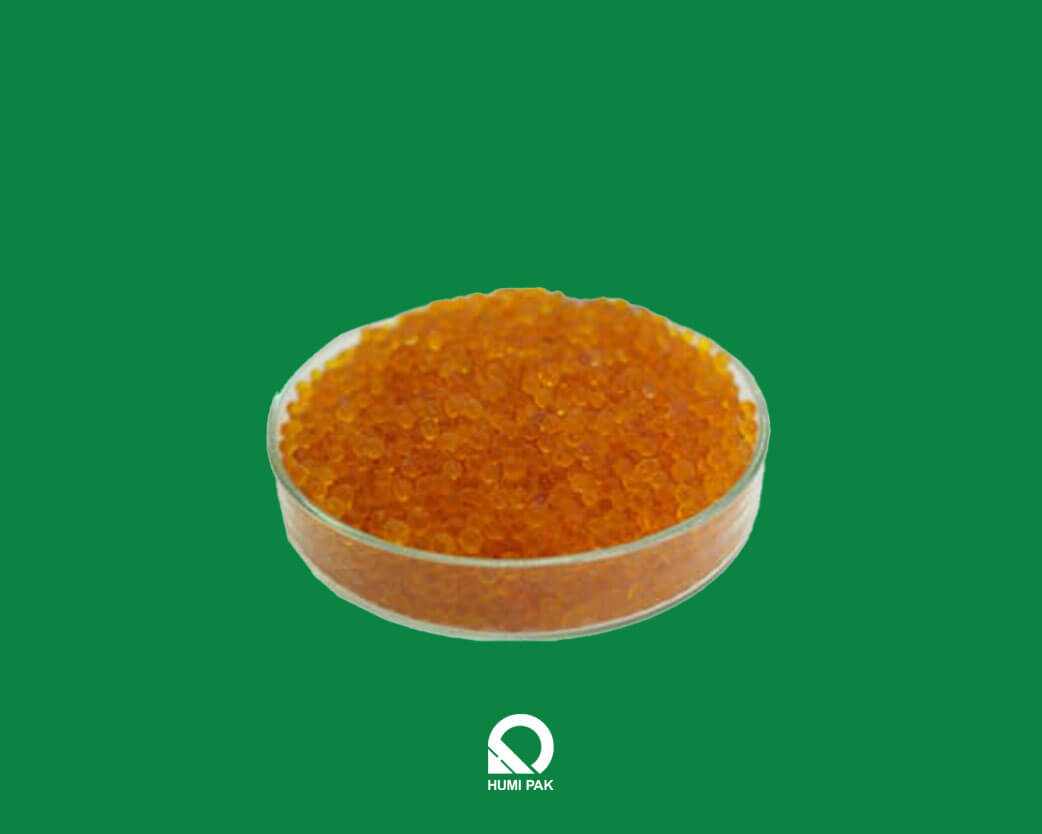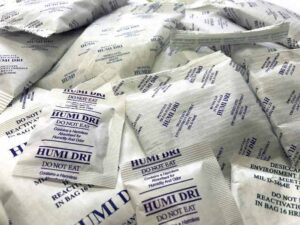What is Silica Gel?

Silica gel, commonly found in small packets within product packaging, is crucial in ensuring product preservation by combatting the detrimental effects of moisture. This article aims to share the importance of silica gel in packaging, its properties, and its varied applications across industries. Join us as we delve into the science and significance of this component in packaging.
Introduction to Silica Gel
Silica gel is a highly porous, non-crystalline silicon dioxide (SiO2) form. It is most commonly known for its desiccant properties, where it works efficiently to absorb moisture and maintain dry environments. These small, translucent white beads have a sponge-like structure internally, giving them their unique ability to lock in moisture.
Nanometer void spaces and a tridimensional arrangement of oxygen and silicon atoms are found in the absorbers. Silica gel xerogel is the liquid/gas substance that fills the voids or pores. Silica gel is also shaped and manufactured as granules. Chemicals are used to create indicating absorbers, which cause a change in colour after it has been saturated.
One might commonly encounter silica gel in small sachets inserted in packaging to protect goods from humidity damage, ensuring that products like electronics, food, pharmaceuticals, and leather remain moisture-free during storage and shipping.
The name “silica gel” can be somewhat misleading, as the substance isn’t gel-like in the typical sense. Rather, it is solid and bead-like in form. Developed in the early 20th century, its primary use has been to control humidity and prevent spoilage or degradation of goods. However, its versatility has seen it utilised in numerous other applications, from industrial purification processes to shoe odour control.
Properties of Silica Gel
Silica gel is available in three colours, white, blue, and orange, in loose bulk or packages for variable humidity detection and control levels.
Because of their high surface area of about 800 m2/g, desiccants can absorb moisture well. Due to its high physical properties, the desiccant is an excellent drying agent for protecting various goods and products from corrosion, contamination, spoilage, and mould development.
Chemical Composition: Derived from naturally occurring silicon, it is synthesised through sodium silicate and sulfuric acid reaction, followed by washing, drying, and activation to produce porous granules.
Appearance and Texture: The desiccant appears as small, clear-to-milky white beads or granules. Certain formulations like blue or orange can be tinted, indicating types that change colour as they absorb moisture. The beads are solid to the touch and have a slightly rough texture. Despite the name “gel,” they are not soft or squishy but rather hard and bead-like.
Absorption Capabilities: The high porosity of desiccant gives it a large surface area (around 800 m²/g), making it extremely effective at adsorbing water vapour from the air. Under optimal conditions, Silica gel can adsorb approximately 40% of its weight in water.
The absorption process is physical rather than chemical, meaning water molecules are held within the gel’s pores through physical adsorption, not chemical reactions. It operates most efficiently at high humidity levels (70-90%) and above freezing. However, its effectiveness can be reduced at high temperatures, typically above 50°C (122°F).
How Does It Absorb Moisture?
At the heart of silica gel’s functionality is a process known as physical adsorption. This porous structure is central to its moisture-absorbing abilities. The primary mechanism behind this is physical adsorption. In this process, water molecules from the surrounding environment attract and adhere to the silica gel’s surface.
But there’s more to it than just surface attraction. The small pores within silica gel create capillary forces when exposed to humidity. These forces pull water vapour into the pores, which undergoes condensation and gets trapped. The sheer vastness of the internal surface of silica gel, with a single gram boasting a surface area of around 800 m², ensures that it has a substantial capacity to adsorb water, making it one of the most efficient desiccants available.
Factors Affecting Its Efficiency
Several factors come into play when determining the moisture-adsorbing efficiency of silica gel. Relative humidity is one such decisive factor. The gel thrives in environments with high relative humidity levels, particularly between 70-90%. In such conditions, its rate of adsorption is optimal.
However, as the relative humidity drops, its efficiency reduces, although it continues to perform its moisture-removal function. Temperature, too, plays a role. While silica gel is versatile and functions across various temperature ranges, its capacity can wane at temperatures above 50°C (122°F). Conversely, at temperatures below freezing, the adsorption process slows down, but the gel continues to be effective.
The size of the silica gel particles also influences its performance. Due to their increased surface area and volume, smaller particles offer a quicker adsorption rate. On the other hand, while larger particles might have a more considerable overall adsorption capacity, they act at a more gradual pace.
Another crucial aspect to consider is saturation. After a certain point, when a silica gel has trapped moisture equivalent to about 40% of its weight, it reaches its saturation point. Beyond this, it cannot adsorb any more water. Fortunately, the efficiency of a saturated silica gel can be restored. This is achieved through regeneration, where the gel is heated, prompting it to release the trapped moisture.
Lastly, the environment in which silica gel operates can also impact its efficiency. If other vapours are present, the gel might adsorb these alongside or even instead of water, which can potentially hinder its primary function of moisture removal.
Types of Silica Gel
Silica gel packets come in various types, each with distinct features and applications. These variations are primarily driven by the need to monitor moisture absorption levels or to tailor the silica gel’s properties to specific applications. By recognising the distinct types of desiccant packets and their features, users can make an informed choice suitable for their specific application, ensuring efficient moisture control.
White/Clear:
- Description: Translucent white or clear in appearance, this type contains no indicating agents.
- Usage: Often used in general-purpose applications where there’s no need to monitor moisture absorption visually.
- Benefits: Pure composition and non-toxic, making it suitable for direct contact with food and pharmaceuticals.
Blue Indicating:
- Description: It begins as a bright blue when dry but changes to pink as it becomes saturated with moisture.
- Usage: Preferred in scenarios that require continuous monitoring of desiccant performance.
- Note: Traditional blue indicating types contain cobalt chloride, raising health concerns. Thus, they’re not recommended for direct contact with food or medicine. Newer, safer variants are available.
Orange Indicating:
- Description: Starts bright orange when dry, transitioning to green or dark green as moisture is absorbed.
- Usage: Used when visual moisture monitoring is essential. It is often seen as a safer alternative to the blue variant due to the absence of cobalt chloride.
- Benefits: Clear colour change makes it reliable for monitoring, and its composition is considered safer for diverse applications.
Common Uses in Different Industries
Across diverse industries, the desiccant plays an indispensable role. Efficiently controlling moisture ensures product integrity, longevity, and quality, underpinning the success of many sectors.
Electronics: In the electronics industry, moisture is a silent adversary. Humidity can lead to corrosion, short-circuiting, and reduced lifespan of components.
Packed alongside sensitive electronic devices and components, from smartphones to circuit boards, these desiccant sachets ensure a low-humidity environment, safeguarding electronic integrity. Furthermore, with the increasing demand for miniaturised electronics, ensuring the internal environment is moisture-free becomes even more crucial, and silica gel plays a pivotal role in this protection.
Pharmaceuticals: The pharmaceutical industry relies heavily on silica gel to maintain medication potency, shelf life, and safety. Many drugs are highly sensitive to moisture, which can lead to degradation, reduced efficacy, or even mould growth.
By placing silica gel packets inside medicine bottles or packaging, pharmaceutical companies can ensure that the drugs remain dry, thereby preserving their therapeutic properties. Moreover, the non-toxic nature of silica gel ensures it doesn’t pose any risk if placed close to consumable drugs.
Food and Consumables: Food spoilage is often a consequence of microbial growth, and moisture significantly contributes to this. Silica gel is used extensively in food product packaging, especially those prone to spoilage in humid conditions.
Examples include dried meats, spices, and even some baked goods. Silica gel helps maintain a dry environment, prolonging the shelf life of these products. Additionally, the packaging of certain perishables prevents condensation build-up, ensuring the freshness and quality of the food.
Clothing and Textiles: Clothing and textiles, especially those stored or shipped over long distances, are susceptible to mould and mildew in the presence of moisture.
Silica gel packets are commonly found in garments, leather products, and shoe packaging. They ensure that these items remain dry and free from any moisture-induced damage. Moreover, preserving their quality is of utmost importance for luxury or delicate fabrics, making silica gel a vital inclusion in their packaging.
Collectables and Storage: For collectors, be it of stamps, vintage comics, photographs, or other memorabilia, the ravages of time and environment, especially moisture, are constant concerns.
Storage boxes or display cases maintain a low-humidity atmosphere, protecting these collectables from potential moisture damage, fading, or degradation. Similarly, in storage facilities or units where valuable items are kept, silica gel is often used to ensure that the contents remain unaffected by fluctuating humidity.
Safety Considerations
Desiccant packets, often found in product packaging, are primarily designed to absorb moisture and ensure the longevity and quality of the enclosed items. While the contents, like silica gel, are generally non-toxic and inert, they are not meant for consumption. The “Do Not Eat” warning is prominently displayed to prevent accidental ingestion, especially since the small packets can be mistaken for food additives or seasonings by some, particularly children.
- Ingestion: If consumed, most desiccants are relatively harmless and pass through the digestive system without being absorbed. However, they can pose a choking hazard, especially for small children.
- Chemical Indicators: Some indicate that desiccants change colour when saturated with moisture. This colour change can be due to chemicals like cobalt chloride, especially in older blue-indicating types. Though the amounts are typically small, cobalt chloride can be harmful if ingested.
- Dust Inhalation: The fine particles can become airborne if a packet breaks open. Breathing in these particles might irritate the respiratory system.
Disposal and Environmental Considerations:
- General Disposal: Used desiccant packets can be thrown away with household waste. However, checking local disposal guidelines or the packet’s label for specific instructions is always recommended.
- Regeneration: Before disposal, some desiccants, like silica gel, can be “recharged” or regenerated by heating, allowing them to be reused. This not only extends their life but also reduces waste.
- Environmental Impact: While many desiccants are inert and pose minimal environmental risks, the packets and the indicating chemicals used can have environmental implications. It’s essential to ensure that harmful chemicals are not released into the environment during disposal. Biodegradable or recyclable packet materials are becoming more common to reduce environmental impact.
Conclusion
Silica gel, a ubiquitous element in packaging, plays a critical role in protecting goods from moisture-related damage. From electronics to food, its presence ensures products retain their intended quality and longevity. As industries and consumers increasingly emphasise effective and sustainable packaging solutions, the significance of silica gel cannot be overlooked.
Simple yet effective, it epitomises the essence of functional packaging, highlighting the importance of the right tools for the right task in preserving products. Humi Pak, located in Malaysia, is an ISO 9001 and 14001 certified manufacturer of silica gel packets. Our in-house QA lab conducts daily quality checks to ensure consistent product standards. For inquiries and more information on our desiccants, please contact us.


